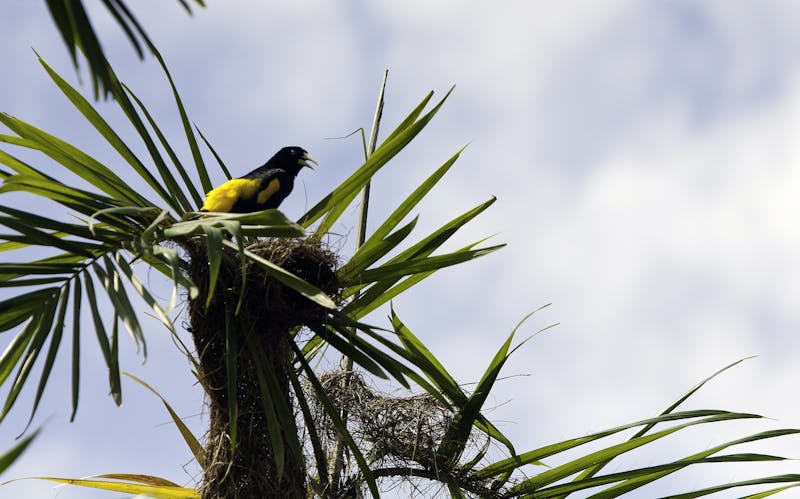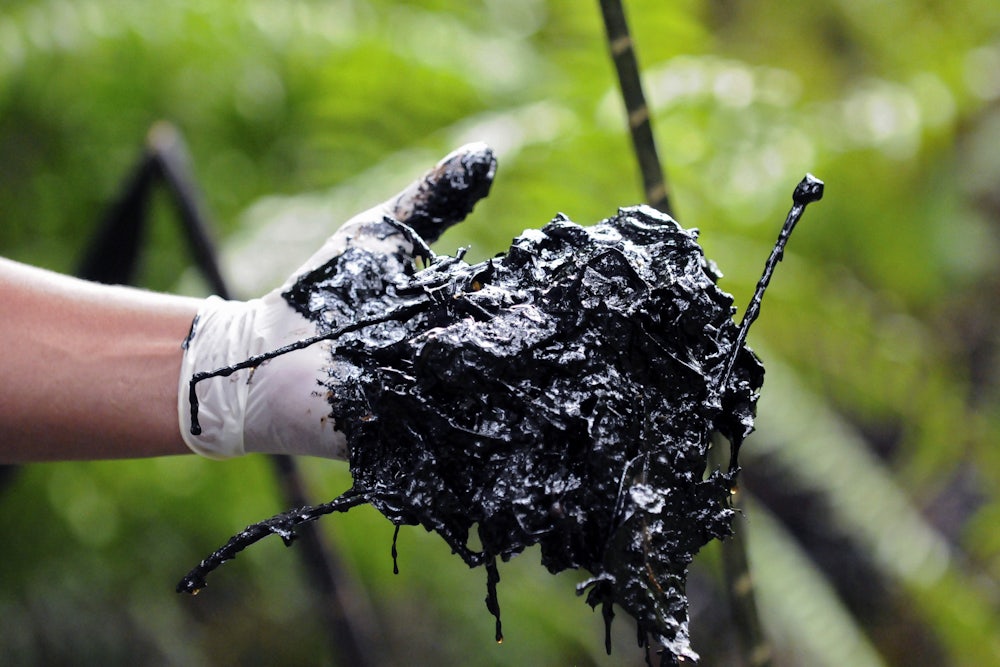On the evening of January 4 2018, Patricia Gualinga was at home when she heard a crash, the cascade of cracked glass. Through her broken window, she heard a man’s voice shouting. He would kill her, he said, if she continued speaking out against natural resource exploitation in the Ecuadorean Amazon.
Gualinga is a member of the Sarayaku indigenous community in the southern part of Ecuador’s Amazon. In the past four months, she and other indigenous women have met every Sunday, organizing a three-day forum in Puyo, attended by hundreds of women, as well as a march for International Women’s Day. On March 17, they went to the capital, Quito, marching to the presidential plaza to demand better environmental practices from President Lenín Moreno. For these women, the environment and human rights are inextricably linked, their identities as women, indigenous people, and Ecuadorans fusing in a unique and powerful mandate for environmental stewardship. And they’ve no intention of backing down.
Ecuador is unique in terms of oil and conservation; it’s an oil producing and exporting (OPEC) country, and its shaky economy depends on oil. But it also enshrines the rights of nature in its constitution, and many Ecuadoreans see themselves as the guardians of those rights.
Indigenous women are taking the lead to protect both the Earth and their own rights, long experience with the extraction process having taught them to see the two as linked. Oil drilling, they argue, has deep repercussions for their health and safety.
Nema Ushigua, the first female president of the Sápara peoples native to the rainforest along the Ecuadorean-Peruvian border, recently began speaking up about the specific risks for women in addition to the indigenous rights she’s been championing for years. She was soon joined by Mirian Cisneros, president of Gualinga’s Sarayaku community; Zoila Castillo, a leader of the Kichwa, the most populous indigenous group in the Ecuadorean Amazon; Gloria Ushigua, a grassroots Sápara organizer; Alicia Caihuiya, of the limited-contact Waorani people; and others.
“We have put ourselves at the forefront of the entire resistance,” Gualinga told me, adding that the Ecuadorean government had “brutally abused” the indigenous women stepping forward by harassing and punishing them, often with crackdowns on protesters. In 2014, the military invaded Sarayaku land, and in 2015 indigenous protesters were beaten and tear-gassed by police during peaceful demonstrations.
Undeterred, Gualinga traveled to the climate talks in Paris later that year to unveil a partnership between indigenous communities vowing to protect native lands around the world. Called Kawsak Sacha, or “Living Forests,” the proposal demanded an end to drilling, mining, logging and other extractive industries on indigenous land, from the Arctic to the equator.
The Moreno administration in Ecuador has gone back and forth on conservation. Last December, Moreno agreed to stop granting natural-resource concessions after an indigenous protest; however, he broke that promise earlier this year when the government announced new oil and mining concessions.
In January, three days after Gualinga received her death threat, Ecuador’s state oil company began drilling in Yasuní National Park, one of the most biologically diverse places on the planet—a subject that has roiled national politics in Ecuador for the past decade. At one point, former president Rafael Correa promised to keep the oil in the ground if the world agreed to pay more than $3 billion; after only 10 percent of that amount was pledged, Correa withdrew the offer.
In recent years, global leaders have increasingly recognized biodiverse regions as important resources—not least for the countless crucial substances for new drugs and medical advances that have come from rainforests like the one in Yasuní. But more immediately, the oil extraction in Yasuní will also harm the health and well-being of the indigenous peoples living in and around the Amazon.
The oil well drilled in January—one of 651 planned in Yasuní—sits on the land of the Waorani people, an indigenous tribe with limited outside contact, as well as two tribes with no contact with the outside world. And future projects will affect close to 60 percent of Sápara territory.
To see the effects oil drilling will likely have on these communities, one doesn’t need to travel far. Just a hundred miles away, near the town of Lago Agrio, environmental activist Donald Moncayo is digging in the ground. He only goes a foot or so deep before stooping to reach into the earth. His hand, when it emerges, is covered in black slime.
More than two decades ago, when Texaco finished extracting crude from this corner of the Amazon and left the country, residents say they began discovering pits of “produced water”—a byproduct of oil-pumping that most oil companies re-inject deep into the earth or submit for treatment. The water, which can contain oil residues and heavy metals, is considered industrial waste.
In 2001, Texaco was subsumed by Chevron, which denies any culpability in Ecuador—despite a legal decision finding the company guilty and fining them an astonishing $18 billion in damages.

The toxic ponds are still there, bubbling black in the intense equatorial sun. Around the pits that have been found so far, the jungle is strangely quiet; even birds and insects fear the water here.
In a small cinder-block house not far from one of the toxic ponds, a man is dying. Cancer, his wife says. The tumors have spread through his rail-thin body, his bones jutting out under waxy skin. Parrots flit through the jungle around his house, and the humid air hangs so close it feels like a physical presence. Here in the rainforest, water is everywhere, collecting in puddles and ponds. Yet neither the man nor his wife dare drink from it, even in this heat.
The toxic water pervades the surrounding soil, too. Dig just a few inches into a local farmer’s field, which once sprouted crops to feed the community, and you’ll find a thick sludge. Through the years, the contaminated water seeped into the groundwater, mixing with the rivers and lakes and wells from which local communities draw water to drink, cook, and bathe. Residents soon began suffering much higher rates of cancer, miscarriage, birth defects, and other health misfortunes, a trend confirmed by a study published in the International Journal of Epidemiology in 2002, finding higher cancer rates closer to the oil fields.
The oil also brings with it another problem, the women say: men. Indigenous Amazonian women, two-thirds of whom according to Ecuador’s ministry of the interior have endured some form of gender-based violence, report higher rates of domestic violence and sexual assault in towns where oil extraction occurs. Many of the oil workers come from other regions and thus exist outside of the local social system.
“When these extraction projects come onto their [indigenous] territory, it’s completely devastating to their way of life—their waterways, their environment, their culture,” says Leila Salazar-López, executive director of the conservation nonprofit Amazon Watch. “But these oil companies and security forces also bring sexual and domestic violence.”
“We women are united, fighting and signing agreements and treaties to prevent that, because we know we are right,” said Gualinga.
Five days after the women marched to the presidential plaza on March 17, President Lenín Moreno agreed to meet with twelve women, representatives from the larger group of protesters; the half-hour meeting extended into an hour and a half, during which the women raised concerns about violence against women and the Amazon.
“The attack on Patricia was a tipping point for women,” Salazar-López says, calling the president’s meeting with the women “history in the making.”
“There had never, ever been a meeting of just indigenous women from the Amazon—grassroots women, frontline community women… demanding a respect for their lives as women,” Salazar-López says. They have “not been given a space but demanded a space at the table.”
If their demands are not met, the women say they will take to the streets once again.
Gloria Ushigua, a Sápara community organizer, is not confident the government will listen to their protests, but she is determined to raise her voice nonetheless.
“I’m fighting for my indigenous Sápara culture,” she says. She would like to see national policies that respect and conserve indigenous land and the people on it. But she is also imploring multinational banks to stop investing in natural resource exploitation.
By fighting to protect their traditional land, indigenous women are making an innovative argument that the lives of the people and the wellbeing of the environment are inextricably linked—and a battle for one is a battle for the other.
“We are fighting for life,” Gualinga said, “and we cannot allow them to make decisions that mean death.”
Melody Schreiber reported on the Paris climate talks on a fellowship with The GroundTruth Project.
